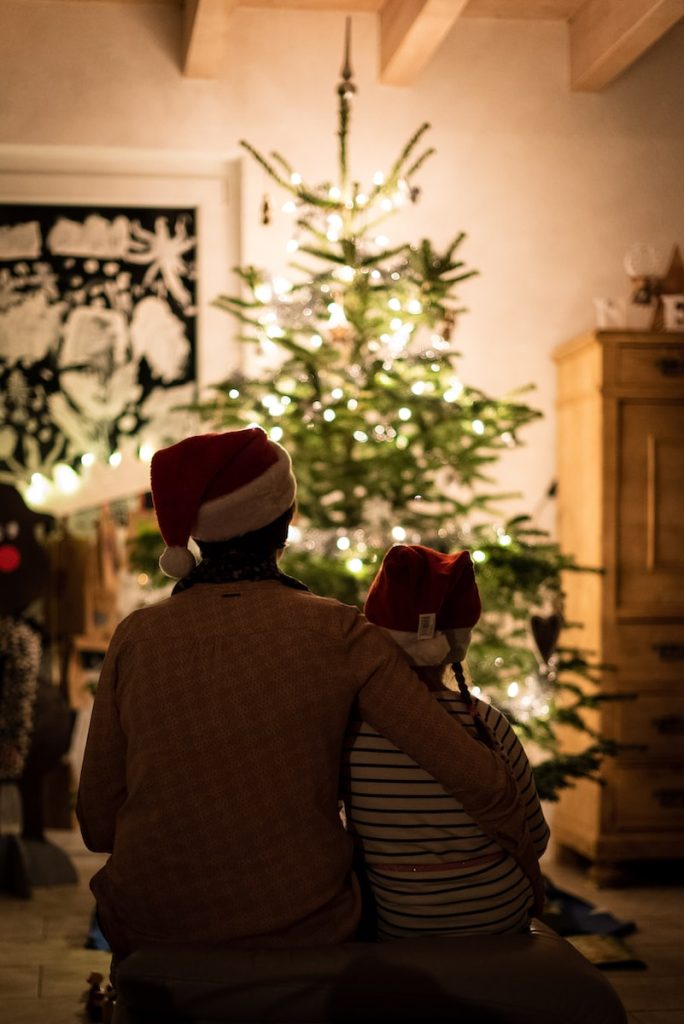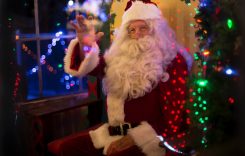What is that heavily decorated tree doing in the middle of our living room? And that brown log-shaped cake on the table? Who are these anachronistically dressed Santons? Find out what’s behind these Christmas symbols that are sometimes more spiritual than we think.
A Christmas tree in the house, what could be more bizarre? And yet, in this month of December 2022, millions of people continue to perpetuate this age-old tradition. Some may also put up a nativity scene, and many will eat yule logs at Christmas. But how many really remember the meaning of these practices? Let’s dive into the history of Christmas symbols, between ancient paganism, Christianity and modern inventions.

The fir tree, the tree that resists winter
If its origin is lost in the meanders of time, we know that the tradition, attested from the 16th century, of decorating religious buildings with a fir tree and plant decorations (moss, branches, mistletoe, holly) spread in Europe from the Germanic and Scandinavian regions, with a Lutheran majority. This presence in the public space is coupled, from the nineteenth century, the gradual appearance of the decorated tree in each home – a tradition that, in France, was spread by the Alsatian diaspora after the war of 1870.
The Christmas tree also finds an echo in the “mais”, a custom consisting of erecting a tree in spring. This fertility rite inspired the twin practice of a “winter may” or “Christmas may” in Alsace and the Black Forest, first documented in 1419.
The highly symbolic figure of this tree that has resisted the death of winter refers to the persistence of life and its future rebirth with the growth of the sun. Christianity sees it as a representation of the tree of life in the Garden of Eden as well as the redemptive cross of Christ.
The star that is placed at the top of the tree also hides a Christian symbolism. It represents the star that guided the Magi to Jesus. “Where is the King of the Jews who has just been born? We saw his star in the east and came to worship him,” we read in the Gospels (Matthew 2:2). Traditionally, the youngest member of the family places it on the top of the tree, as a symbol of the Christian Nativity. But it also echoes the pagan celebrations of the coming rebirth of spring.
At first naked, the tree will be covered over time by various decorations, and in particular by apples, referring again to the symbolism of the tree of knowledge of good and evil mentioned in the Book of Genesis. It is said that a shortage of apples in the mid-nineteenth century led glassmakers to invent blown balls to replace them.
As for the garland, the original meaning of the word identifies it with the wreath of flowers – which is its curved and knotted version – already in use in some ancient celebrations as a symbol of vitality. By their shimmering colors, the garlands recall these assemblies of flowers, and sometimes fruits, representing abundance.
These decorations have a protective function
The tradition of placing candles on the tree or, more recently, illuminated garlands, also testifies to the syncretism of Christmas. In line with the ancient celebration of the god Sol Invictus (the “unconquered Sun”), these lights celebrate the gradual return of the sun. In resonance with the star placed on the top of the tree, they would also refer to a cosmic representation by the reproduction of the starry sky. This symbolic dimension drawn from Antiquity is coupled with a Christian reference associating light with the truth incarnated by Christ.
Finally, in addition to the tree, the plant decoration is traditionally accompanied by mistletoe and holly, whose presence in homes is also prior to that of the tree. Their symbolic value is very anchored since Antiquity, especially among the Celts. Perhaps because they remain when others are no longer, these evergreen plants are associated with a beneficial nature. These decorations are essentially intended to protect against the intrusion of witches or evil spirits – all creatures of death repelled by greenery, associated with summer and life.

The crib, symbol of the nativity
The idea of the crib – from the Latin præsepe, originally meaning a cattle pen – comes mainly from the story in the Gospel of Luke, which tells of Jesus’ birth in a place where animals eat. Francis of Assisi is credited with creating the first living nativity scene in the cave of Greccio, Italy, in the 13th century.
The oldest cribs found in churches date from the 16th century and are made up of miniature figures. After the Revolution and the closure of many places of worship, the custom of the crib developed more and more in the private sphere, especially in Provence. In 1803, the first market of santons, hand-painted clay figurines, took place in Marseille. But what do the Christian texts really say about it? Why does the scene take place in a cave or a stable?
Tradition tells us that, having come to Bethlehem in Judea for a census, Mary and Joseph struggled to find a place to spend the night. It seems that they ended up taking refuge in a stable, because according to the Gospel of Luke, Jesus was born in a manger (2, 7): Mary “gave birth to her firstborn son; she wrapped him in swaddling clothes and laid him in a manger, for there was no room for them in the common room.”
Matthew also mentions his birth in Bethlehem, but without further details. The apocryphal gospel of Pseudo-Matthew, written between 600 and 625, tells us more. At the urgent command of an angel, Mary enters a cave lit by a miraculous light. There she rests and gives birth to a son. Two days later, she took refuge in a stable and laid Jesus in a manger.
“The nativity scene is a syncretism because, like Christmas, it lies at the confluence of ancient traditions. The Gospels say almost nothing about the place and atmosphere of this event. But, at one point, it is decided that the birth of Christ occurs in a cave, like many ancient gods who were born there – Mithras, Hermes, Dionysus … This symbolizes a birth under the seal of threat and violence, like that of Jesus threatened by Herod, “analyzes the Italian philologist Maurizio Bettini, author of Christmas. Aux origines de la crèche (Seuil).
In the crib, Mary is usually kneeling next to the Baby Jesus, in an attitude of adoration. For his part, Joseph is generally represented standing, slightly behind the manger, with a pilgrim’s staff in his hand. Jesus is of course the main character, around whom the whole crib is organized. He is generally represented lying down, sometimes naked, most often swaddled. According to tradition, we wait until the night of December 24 to 25 to place him.
The angel Gabriel is also usually present. Placed most often in overhang, he is “the angel of the Lord” of which Luke speaks. It is he who proclaims the “good news” of the birth of Jesus and alerts the shepherds, the first to learn of the birth of the Messiah and other key figures in the iconography. They gather around the stable, followed by their sheep. Sometimes they carry a lamb on their shoulder as an offering.
As for the Three Wise Men, there are three of them… at least in the cribs. Because in reality, their number is unknown. The Gospels just use a plural. We can only assume that they symbolize the submission of the pagan elite, the Persian or Babylonian scholars, to the Revelation. Later, in the second and third centuries, Tertullian makes them kings, Origen adds that there were three.
Their identity is fixed according to a theory formulated by Bede the Venerable in the 8th century: Melchior is a wise old man embodying Asia, Gaspard the African is young, and Balthazar, in his prime, embodies the Semites and Europeans. This representation, which marks the progressive submission of an ancient world to the message of Christ, was reinterpreted during the Renaissance. The iconography represents the three wise men bending their knees in wonder before a radiant Jesus. At that time, defining the Nativity also appeared to be a power issue: the triumphant Europe was now represented by Jesus, the future “king of the world”. Imposing the image meant shaping thoughts.
The cribs also feature the donkey and the ox. Completely absent from the biblical accounts of Christ’s birth, they appear alongside him in a 4th century bas-relief, the sarcophagus of Stilicho, in the Basilica of St. Ambrose in Milan. The apocryphal Gospel of Pseudo-Matthew also mentions them: “Two days after the birth of the Lord, Mary left the cave, entered a stable and laid the child in a manger, and the ox and the donkey, bending their knees, adored him. Then the words of the prophet Isaiah were fulfilled, saying, “The ox knew his owner, and the donkey his master’s crib,” and these animals, while surrounding him, worshipped him continually. Then the words of the prophet Habakkuk were fulfilled, saying, “You will manifest yourself in the midst of two animals.”
In this text, the ox and the donkey emphasize the dual nature of Jesus, human and divine. Traditionally, the donkey is the mount of prophets, such as Balaam. It is also on the back of this animal that Jesus will enter Jerusalem (Luke 19:32-36), fulfilling the prophecy of Zechariah (Zechariah 9:9): “Behold, your king comes to you; humble, he comes riding on a donkey, on a colt, the young of a beast of burden.” The ox is the animal symbol of the most famous rival of Christ, the ancient god Mithras; to see him kneel before the child is not insignificant.
And what about the famous santons? These folkloric, and often anachronistic, figures do not appear in the biblical accounts either and were born of popular tradition. They represent all sorts of jobs – the olive picker, the miller, the drummer, the mayor, the priest… – who bring the fruit of their labor to the Child Jesus. Placed on a hill, or on a river bridge, not far from an olive tree, they are witnesses to the birth of Christ, bringing a bucolic note to the scene.

The log, from the ritual fire to the Christmas Eve table
Chocolate or fruit, rolled or iced, this cake is on every table on Christmas Eve, whether you are in France, Belgium, Quebec, Vietnam or even Lebanon. But what is its origin? In reality, the pastry only appeared at the end of the 19th century in France. “If some grant the paternity to Pierre Lacam who was in the service of Prince Charles of Monaco, there is a stronger chance that it was created by a chef of the pastry shop Quillet, rue de Buci in Paris, the same one who invented the butter cream,” according to Nadine Cretin, doctor in history, author of Fêtes de la table et traditions alimentaires (Le Pérégrinateur, 2015).
Read also: Article reserved for our subscribers Bûche, oh my bûche… Our selection of the 15 most gourmet creations for Christmas
The dessert became popular in the 1950s, when the Christmas meal was standardized around copious dishes: oysters, foie gras, turkey with chestnuts … Obviously, during the “thirty glorious years”, the table should be a sign of abundance.
When the new log was burning, it was supposed to keep away the ghosts
Nevertheless, before being a pastry, the Yule log was a piece of wood that was burned in the fireplace according to a sacred ritual that could sometimes be Christianized. Sometimes oil and wine were poured on it, sometimes holy water and wax, and people knelt down in front of it. According to the beliefs of each one, the regions and the times, the custom developed a little everywhere in Europe (France, Spain, Italy, Austria, England…) by conveying a good number of superstitions.
“When the new log burned in the fireplace, it was supposed to keep ghosts away,” says Nadine Cretin. As the only place in the house that remained open to the sky, the fireplace brought as many blessings as worries. In Provence, the log was consumed during the cacho fio ceremony (expression designating the log), one said: “God grant us the grace to see the coming year. If we are not more, may we not be less!”
According to the historian, the origin of this custom could go back to the Celts, around 600 BC: “A new fire was rekindled during Samain, a Celtic festival that later gave birth to Halloween. It heralded the cold season and the new year, at the beginning of our month of November.”
In late antiquity, a fire ritual celebrating the winter solstice will also appear in the Northern Hemisphere around December 21. “At the time when the trees were stripped of their greenery, they were brought into the house, which was a sign of hope. For the new year, they were looking for prosperity for the family, the livestock and the crops,” she adds.
Depending on the region, the wood could come from an oak or a beech tree, both signs of robustness, or from fruit trees, because “the more the wood cracked, the higher the sparks rose, the more prosperous the crops promised to be”. It burned only one night, or was gradually consumed during the twelve days between Christmas and Epiphany.
Read also: Article reserved for our subscribers Our selection of shows for Christmas: theater, opera, dance, musicals, comedy, puppets …
To the Church, which was offended on several occasions by this ritual conveying beliefs that were not its own, the historian François Lebrun replies: “In a world where dangers were everywhere, where God and the devil were constantly at work, it was necessary to reconcile by all means these natural forces that governed the happiness and misfortune, the life and death of each. In addition to the ceremonies and prayers of the Church, it seemed normal either to reinforce its effectiveness by complementary practices, or to resort to those of a parallel religion, magical, agrarian and cosmic.”
Read also: Article reserved for our subscribers How to avoid that children discover that Santa Claus does not exist?
If, since the beginning of the 20th century, the world has changed and superstitions have retreated, it remains that today we still wish to augur each new year of abundance and success during this festive evening.










